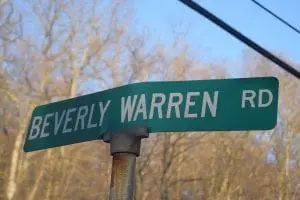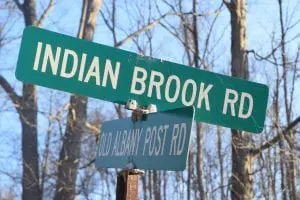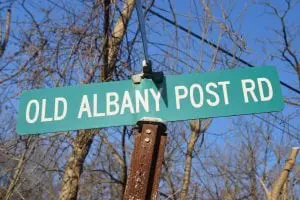From Indian princesses to Revolutionary War heroes
By Michael Turton and James Kelly
In October, The Current looked at the history of street names in Cold Spring. Now it’s time to travel around Philipstown.
Arden Drive
Named for Colonel Thomas Arden, who in the 19th century owned what is now the Highlands Country Club. Arden Point, a.k.a. Flat Rock, also bears his name. Arden was a graduate of West Point and fought with the 124th New York State Volunteers in the Civil War.
Barrett Pond Road
Named for Colonel James H. Barrett, a Revolutionary War hero who fought with the colonial militia at the Battles of Lexington and Concord.
Beverly Warren Road
Named for the owner of Warren’s Tavern, which was built in 1761 and operated until 1832. It later became the Bird & Bottle Inn. Warren was the great-grandfather of Emily Warren Roebling who, after her husband Washington Augustus Roebling fell ill, supervised the building of the Brooklyn Bridge.

Foundry Pond Road
Named for the pond that feeds Foundry Brook, the stream that provided power to the West Point Foundry and was once known as Margaret’s Brook.
Hustis Road
Named for one of the first families to settle in the area, including David Hustis in 1730. The family owned most of the land on the eastern side of Mount Beacon, from present day Vera’s Philipstown Market to the Dutchess County line. The Hustis family operated a dairy farm and delivered milk, cheese and eggs.
Indian Brook Road
May have derived its name from an old wive’s tale about a romance between a Native American woman and a member of Henry Hudson’s crew. Thomas Rossiter, the 19th century artist and Cold Spring resident, created an illustrated poem based on the tale. The father of an Indian princess denies her permission to marry Hudson’s mate. Brokenhearted, she kills herself by jumping off Indian Falls or, in Rossiter’s version, Breakneck. The road is included in the National Register of Historic Places.

Jaycox Road
Named for another of the area’s earliest families, including Joseph Jaycox, who was mentioned in a survey of area roads in 1745.
Manitou Station Road
Known as Highland Station Road until 1915, it was renamed after Manitou Mountain, located on the north side of Anthony’s Nose. The road terminated at the Highland Chemical Works, which in the mid-19th century employed 80 people and produced some 52,000 pounds of sulfuric acid a day. Once a bustling industrial center, Manitou Station is now a whistle-stop on the Metro-North Hudson Line.
Old Albany Post Road
Listed in the National Register of Historic Places, it was part of the first road to link New York City with Albany, following trails established by Native Americans. It is one of the oldest unpaved roads in the U.S.

Old Highland Turnpike
Route 9 was called Highland Turnpike until the 1920s. Fragments of the original road use the prefix “Old.” The turnpike was designed as a flat, wide toll road, while Old Albany Post Road was a stagecoach route.
Old West Point Road
Before Cat Rock Road was connected with Highland Turnpike this road led to the ferry to West Point.
Phillipse Brooke Road
Named for Adolph Phillipse, a wealthy and politically minded merchant from New York City. In 1697 he purchased land encompassing present-day Philipstown from two Dutchmen, Lambert Dorlandt and Jan Sybrant, who had purchased a deed to the same land from Native Americans 10 years earlier. Phillipse is sometimes called “the first citizen of Philipstown.”
Stage Coach Road and Diamond Hill Road
These names have a historic ring to them but were only named in the 1990s when Philipstown’s fire departments asked that unnamed roads be called something for safety reasons.
Travis Corner Road
Named for Titus Travis, who settled in the area prior to the Revolution. The former Travis mansion can be seen just north of the corner of Travis Corners Road and Route 9.


Interesting article. Apparently Whitehill Place is named after the builder of the homes on that street. It’s a shame that when the village replaced the dilapidated street sign last year, they replaced it with one that reads “White Hill Place.”
Enjoyed this history from Mssrs. Turton and Kelly.
One slight clarification: John Augustus Roebling was the designer/engineer of the Brooklyn Bridge. In June 1869, while standing on the dock at Fulton Landing, his foot was crushed by an incoming ferry and his toes had to be amputated. He refused any further treatment, contracted tetanus and died about a month later. His son, Washington Augustus Roebling, was listed as assistant engineer on the bridge. It was he who was married to Emily Warren.
Washington contracted caisson disease, i.e., “the bends,” while helping fight a fire in one of the sunken pneumatic structures that he designed. That ailment and numerous other health issues incapacitated Washington, and moving forward, despite the formality of Emily insisting her husband still be listed as chief engineer, it was Emily Warren Roebling who was the day-to-day supervisor and project manager to the bridges completion, making her, by some historians observations: the most powerful woman in America at that time (1800s).
Thanks, Barry. I have corrected this in the story.
I always thought Beverly Warren Road was named for Beverly Warren, a Cold Spring resident who was killed in a car crash in Peekskill in the 1980s.
We both may be incorrect. In 1797, a “road through the woods” was bequeathed by Thomas Davenport, a pioneer of Philipstown, to his grandson Beverly Warren. “It was known and marked for many years as ‘Beverly Warren Road,’ ” wrote Dorothy Giles and Irma Franklin in their 1962 genealogy of the Davenport family. “During the Revolution, troops of the Connecticut Line camped along it.”
A fascinating history of Continental Village was written by Carlton B. Scofield, past Peekskill historian. He was present at the 1921 dedication of “The Monument” to the Mothers of the American Revolution. He traces the creation of the Queen’s Highway in 1723, which thereafter became the King’s Highway and then Old Albany Post Road. You can find this treasure on our town website.
Anyone know how Snake Hill Road got its name?
Snake Hill Road could owe its name to the winding path that it follows. Or of course it could have something to do with snakes!